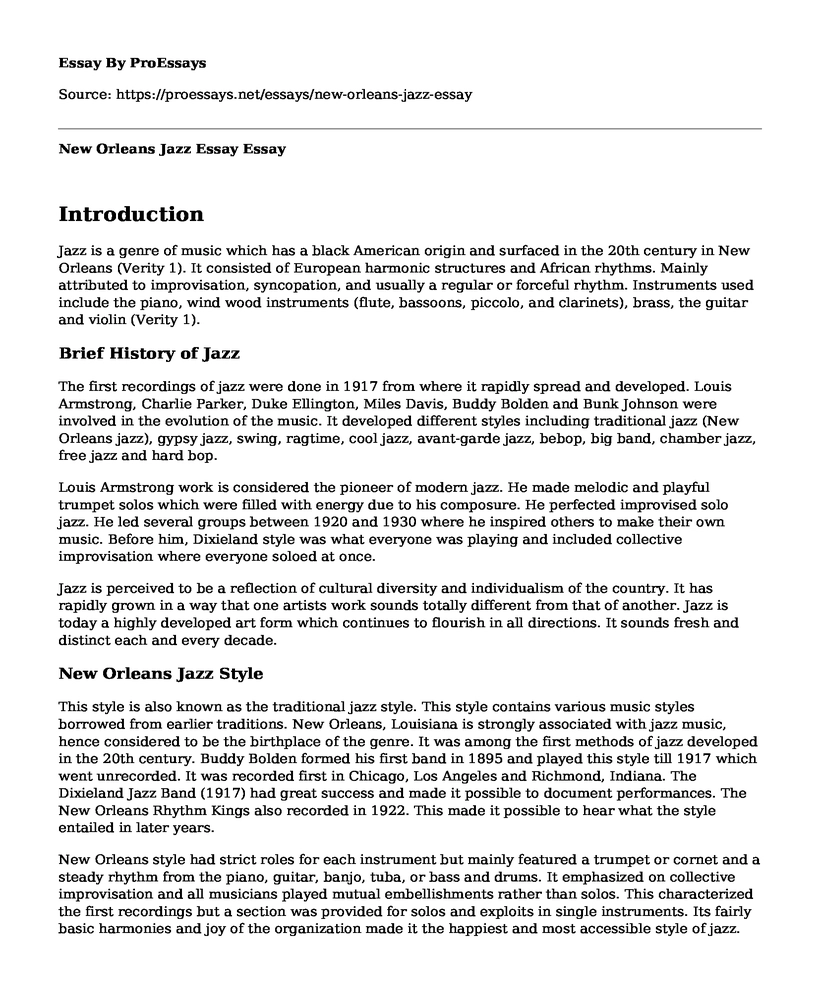Introduction
Jazz is a genre of music which has a black American origin and surfaced in the 20th century in New Orleans (Verity 1). It consisted of European harmonic structures and African rhythms. Mainly attributed to improvisation, syncopation, and usually a regular or forceful rhythm. Instruments used include the piano, wind wood instruments (flute, bassoons, piccolo, and clarinets), brass, the guitar and violin (Verity 1).
Brief History of Jazz
The first recordings of jazz were done in 1917 from where it rapidly spread and developed. Louis Armstrong, Charlie Parker, Duke Ellington, Miles Davis, Buddy Bolden and Bunk Johnson were involved in the evolution of the music. It developed different styles including traditional jazz (New Orleans jazz), gypsy jazz, swing, ragtime, cool jazz, avant-garde jazz, bebop, big band, chamber jazz, free jazz and hard bop.
Louis Armstrong work is considered the pioneer of modern jazz. He made melodic and playful trumpet solos which were filled with energy due to his composure. He perfected improvised solo jazz. He led several groups between 1920 and 1930 where he inspired others to make their own music. Before him, Dixieland style was what everyone was playing and included collective improvisation where everyone soloed at once.
Jazz is perceived to be a reflection of cultural diversity and individualism of the country. It has rapidly grown in a way that one artists work sounds totally different from that of another. Jazz is today a highly developed art form which continues to flourish in all directions. It sounds fresh and distinct each and every decade.
New Orleans Jazz Style
This style is also known as the traditional jazz style. This style contains various music styles borrowed from earlier traditions. New Orleans, Louisiana is strongly associated with jazz music, hence considered to be the birthplace of the genre. It was among the first methods of jazz developed in the 20th century. Buddy Bolden formed his first band in 1895 and played this style till 1917 which went unrecorded. It was recorded first in Chicago, Los Angeles and Richmond, Indiana. The Dixieland Jazz Band (1917) had great success and made it possible to document performances. The New Orleans Rhythm Kings also recorded in 1922. This made it possible to hear what the style entailed in later years.
New Orleans style had strict roles for each instrument but mainly featured a trumpet or cornet and a steady rhythm from the piano, guitar, banjo, tuba, or bass and drums. It emphasized on collective improvisation and all musicians played mutual embellishments rather than solos. This characterized the first recordings but a section was provided for solos and exploits in single instruments. Its fairly basic harmonies and joy of the organization made it the happiest and most accessible style of jazz.
The term New Orleans style was used by journalist between 1915 and 1930 to christen black musicians performing in Chicago (The National Park Service 2). These included Luis Armstrong (trumpeter), Sidney Bechet (saxophonist), Jimmie Noone (clarinetist), Warren Dodds (drummer) and Johnny Dodds (clarinetist). Armstrong and Bechet helped to change emphasis away from group improvisation to a focus on individual improvisation (The National Park Service 3).
New Orleans jazz had an African influence whose roots can be traced back to Congo Square (The National Park Service 4). Slaves would gather to play music and dance on Sundays. African and local music was played and also a taste of European music forms was included hence the great integration and cultural mix associated with this style.
Works Cited
The National Park Service. "A New Orleans jazz history, 1895-1927," 2015, www.nps.gov/jazz/learn/historyculture/jazz_history.htm. Accessed 17 April, 2019.
Verity, Michael. "An Introduction to Jazz Music," 2019, https://www.thoughtco.com/an-introduction-to-jazz-music-2039582. Accessed 17 April, 2019.
Cite this page
New Orleans Jazz Essay. (2022, Mar 07). Retrieved from https://proessays.net/essays/new-orleans-jazz-essay
If you are the original author of this essay and no longer wish to have it published on the ProEssays website, please click below to request its removal:
- The Statue of Zeus at Olympia - Research Paper
- Movie Analysis Essay on Pink Boy and Growing Up Trans
- 12 Monkeys Film Analysis Essay Example
- Movie Analysis Essay on Alex Gerald's Ex Machina
- Paper Example on Fantasy & Illusion: Tennessee Williams' 'The Streetcar Desire'
- Essay Example on Spotify: From Piracy to a Billion-Dollar Music Streaming Giant
- Free Paper on Blues Music: Shaping Identity and Community Bonds Through Song







